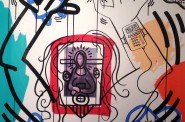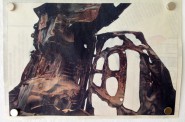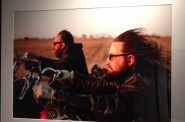All the Stuff of Life
The Haggerty presents four new exhibitions all probing the role of consumer products in our lives.

Jason Ramey, “193.14307,” on view in Aesthetic Afterlife.
In the exhibition Aesthetic Afterlife a work by artist Jason Ramey uses an old desk, which he alters intriguingly to consider the longevity of seemingly disposable furniture, and the place of such things in our life. I recognized it immediately; I had the same type of desk as a child, which was a much-beloved piece of furniture.
What is the stuff of a good life? You may immediately think of relationships, deep meaning, career accomplishments, but there are also all the physical objects of our life which can contain much meaning. Such the basis for four new exhibitions at the Haggerty Museum of Art, all running together (in a rather unusual programming decision) through May 18th, all examining the role of various objects, often consumer products, and their impact on our lives.
The exhibition Between Critique and Absorption teases out aspects of consumerism through the work of Kota Ezawa, Gabriel Kuri, Josephine Meckseper, Kaz Oshiro, Dan Peterman, and Shinique Smith. Their approaches vary, from a video installation that pictures the Mall of America in surreal Martian red, to woven tapestries of receipts, to a podium made of the amount of plastic material used by the average American in a year.
Kota Ezawa’s New! ($2.99/ea), 2007, appropriates Ikea advertising for sleek light boxes of flat shapes and literally luminous color. The source material is all about presenting the image of a beautiful, stylish life that can be yours, neatly presented in flat boxes. Such is the language of sales, but these things tend to be temporary. Ikea is not really known for producing heirloom objects.
Brian Ulrich is featured with three related photographic series. Retail presents a sort of life cycle of consumerism. The abundant overflow of products for the consumer world, plus the sometimes humorous vignettes to be found in stores, permeate this suite. Ulrich’s semi-secretive images, shot using a camera unobtrusively held at the waist, often have the sensibility of a street photographer tinged with Diane Arbus-like wit. The afterlife of consumer goods forms the backdrop to Thrift: photographs of resale shops with tangled piles of goods on shelves and in back rooms, with cost-conscious shoppers as protagonists. The absence of human presence makes the images of Dark Stores notably haunting. Abandoned big-box stores and malls are shown in various states of decay like futile dreams of prosperity.
The exhibition Aesthetic Afterlife brings together installations by six Wisconsin artists who employ found objects, thrift store items, and newly-created source material to explore and critique the purpose, status, and function of objects in our lives. How are they imbued with meaning or a place of importance, either as utilitarian objects or indicators of aspiration and personality? Works such as
William Andersen’s Global Nomad Chic play off status as symbolized by designer labels while Niki Johnson’s commemorative plates glitter with gold leaf as a nod to monetary value. Chairs and furnishings, often discarded by curbsides, take on new roles as sculptural pieces. Jason Ramey’s aforementioned work alters a desk by inserting a wall within it to play with the question of its longevity. The factory stamp and unfinished back allude to the mass-production of the desk, but also to the accessibility of affordable furniture that is not lacking in decorative detail. It becomes a piece whose function is for questions of the mind — that, perhaps is its afterlife — rather than practical use in the home.
The proliferation of domestic items in the nineteenth century underlies the exquisite exhibition The Print Room by the Chipstone Foundation. Always instructive, the Chipstone excels in combining scholarly historical information in gorgeously elegant installations. The works on view reflect the proliferation of transfer-print ceramics with images ranging from famous people, places, and artworks. They represent the growing accessibility of increasingly visual culture in the wake of the Industrial Revolution, and prefigure the ongoing presence of materials in our lives similarity printed with logos, slogans, pictures, and messages. The decorated coffee cup you might use finds a distant ancestor in this thoughtful, impressive exhibition.
Between Critique and Absorption, Brian Ulrich: Copia – Retail, Thrift and Dark Stores, Aesthetic Afterlife, and The Print Room continue at the Haggerty Museum of Art (13th and Clybourn Streets) through May 18, 2014.
OPENING THIS WEEKEND
FRIDAY, JANUARY 24

Branding Creativity kicks off tonight at UW-Parkside, followed by a reception at the Racine Art Museum.
UW-Parkside Galleries
900 Wood Road, Kenosha
Exhibition opening from 5 to 8pm
Opening reception to follow at the Racine Art Museum
441 Main Street, Racine
8 to 11pm
Art and commercial culture come together in this exhibition of more than 20 artists, who reinterpret and reinvent well-known logos and brand images. The exhibition opening at UW-Parkside and the Racine Art Museum will also features live music and theatre, plus ice sculpting at the museum.
Collaborative Design: Great Minds Think Together
2200 E. Kenwood Boulevard
5 to 8pm
7PM, Q&A with artists Reginald Baylor, Adam Carr, and Sonja Thomsen
Art comes together with fields such as health science design and engineering, theater and gerontology, fine art and storytelling in this new exhibition.
Emily Litjens: Wall Dressings
820 E. Locust Street
7 to 10pm
Emily Litjens kicks off Cocoon Room’s 2014 exhibition schedule, with music at the opening reception provided by Larry Wish, Diva 93, and Bob Katz.
Art
-
It’s Not Just About the Holidays
 Dec 3rd, 2024 by Annie Raab
Dec 3rd, 2024 by Annie Raab
-
After The Election Is Over
 Nov 6th, 2024 by Annie Raab
Nov 6th, 2024 by Annie Raab
-
The Spirit of Milwaukee
 Aug 30th, 2024 by Annie Raab
Aug 30th, 2024 by Annie Raab
Art Date
-
Apocalypse Now
 May 30th, 2014 by Kat Murrell
May 30th, 2014 by Kat Murrell
-
Slower Than a New York Minute
 May 16th, 2014 by Kat Murrell
May 16th, 2014 by Kat Murrell
-
Easy Rider
 May 9th, 2014 by Kat Murrell
May 9th, 2014 by Kat Murrell





















Great review, Kat, and after reading it I can’t wait to see the new art exhibitions at the Haggerty! Thank you!